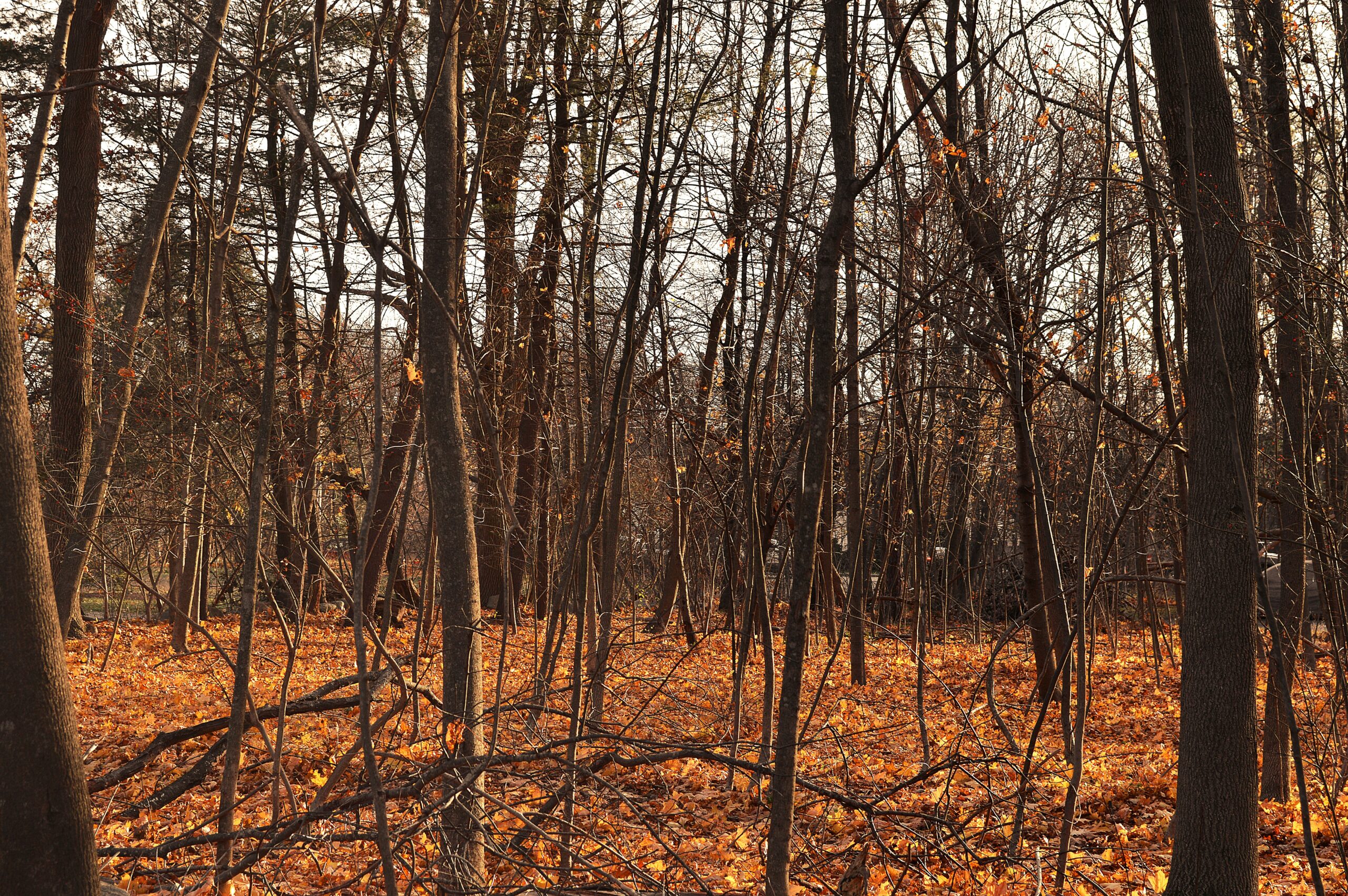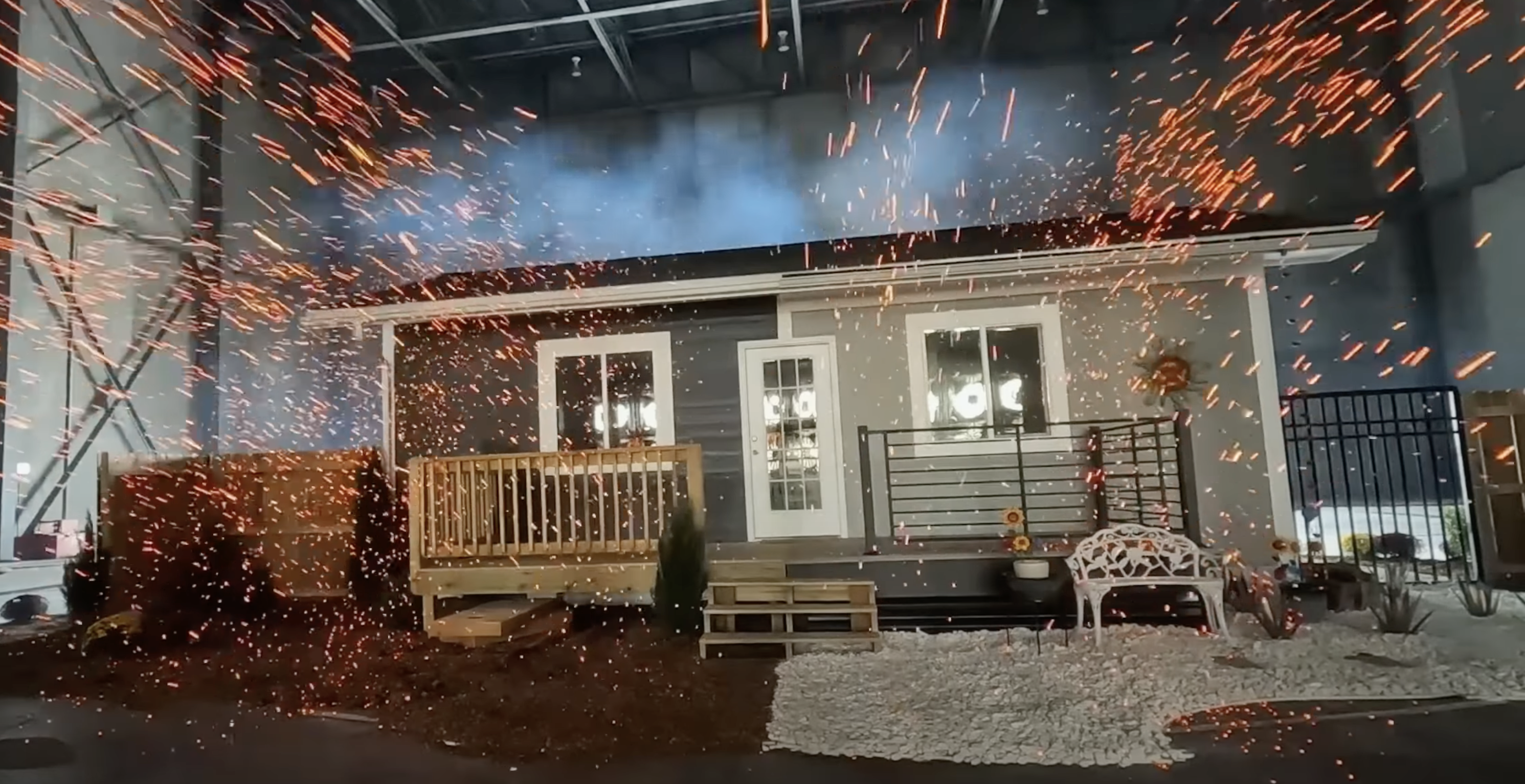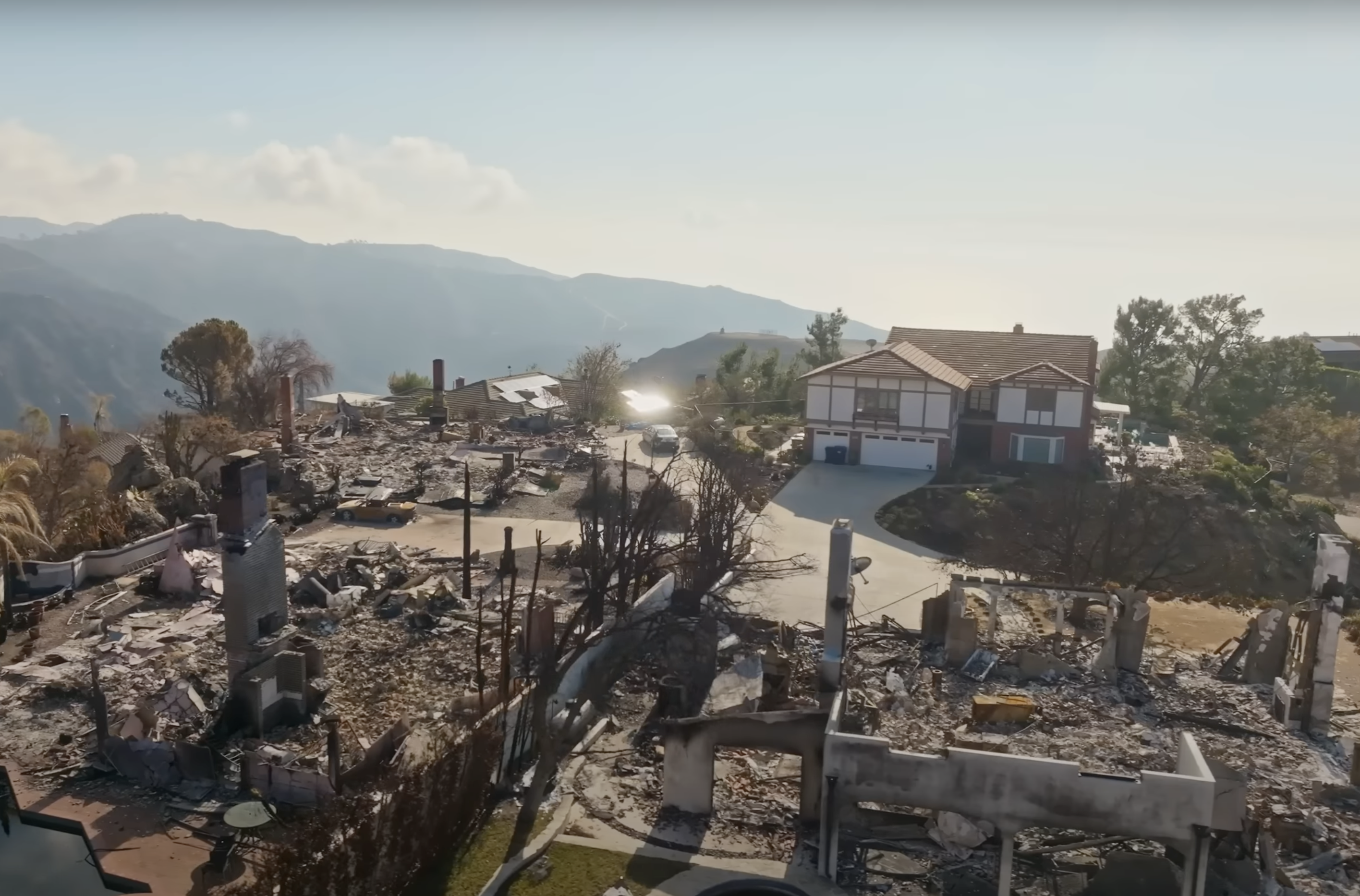Home Hardening 101: Keep Your Property Safe From Wildfires and Urban Conflagration
. Posted in News - 0 Comments
By Kimberly Rau, MassLandlords, Inc.
How do you protect your home against fire damage from the outside in? It’s a question you should be asking, especially in areas where homes do not have a lot of space between them, and fire activity shows no signs of slowing down. While you may think of wildfires as a west coast phenomenon, the truth is, Massachusetts is no stranger to wildfire activity.

“Day turns to night.” Traditional methods for fighting wildfires go out the window when wind and neighborhoods become involved. Learn how to protect your property’s exterior from embers and flames. (License: Ross Stone for Unsplash)
In January 2025, the world watched as wildfires swept through Los Angeles County in California, killing 29 people, destroying 16,000 structures and causing more than $32 billion in damage. And while the firefighters of L.A. County are considered some of the most elite in the field, with extensive training in fighting wildfires, it wasn’t enough to stop the destruction. Part of the reason was because once one house in a densely-settled neighborhood catches fire, the odds are good it will spread to other homes. This urban conflagration can quickly overwhelm even the most well-trained firefighters and drain even the most generous of resources.
Massachusetts may not be as fire-prone as certain parts of California, but it is not immune to wildfires and the destruction they bring. All of us know vinyl siding can catch fire or melt when a neighboring house goes up in flames. Some siding even melts from nearby window reflections. And with climate change creating more opportune conditions for blazes, homeowners must be aware of what they should do to protect or “harden” the exterior of their homes to prevent fire from spreading between structures.

Dry conditions plus a constant supply of falling leaves can leave Massachusetts forests susceptible to wildfires. (Image: Tyke Jones for Unsplash)
Wildfires Consumed 4,000 Acres in Mass. Last Fall
In the fall of 2024, fire officials report that approximately 4,000 acres burned in Massachusetts in just two months. This represented a historic number for the state. Drought, wind, low humidity and constantly falling leaves created a perfect breeding ground for wildfires, with some areas re-igniting several times over the season.
Mass. chief fire warden Dave Celino spoke to WGBH about the fires, noting that with the Pappas fire in Canton, 35 acres actually burned three times.
“The ground was hot, the fires were burning into the soil,” he stated. “It was a hot surface to the forest. And then we had continuous leaf drop every single day, and so that stuff would burn on.”
Even if homes are not directly in a fire’s path, embers can cause a structure to ignite. Once one structure goes up, others may quickly follow. Celino discussed ways that homeowners can protect their buildings. His advice matched what other experts who evaluate wildfires suggest.
To learn how to protect your property, you first need to understand how wildfires operate, and what causes them to get out of control.
Traditional Techniques Not Always Effective for Wildfires
In March 2025, PBS Terra produced a documentary called “The Real Story of the LA Fires.” The video offers an in-depth look at the L.A. wildfires, the factors that led to the burning of entire neighborhoods, and discusses what, if anything, could have been done to prevent such destruction. We will summarize the main points of the documentary here, but the full video, nearly an hour in length, is well worth your time to watch in its entirety.
As was the case with the smaller fires in Massachusetts, an extended dry spell created prime conditions for wildfire in Los Angeles County. Add in heat and wind gusts that reached up to 80 mph, and at a certain point, there was no stopping the fires once they spread. In Eaton Canyon, observers described the fire that would reach the neighborhoods as a “river of lava.” Residents attempted to evacuate their homes, got stuck in gridlocked traffic, and abandoned their cars as they fled for their lives. People returned after the fires to find entire neighborhoods destroyed.
And while some were inclined to blame faulty infrastructure and lack of funding for the fire damage, the problem was not a lack of resources. Fire experts agreed that there would never have been enough resources to mitigate a fire at that level and scale.
“Could we have used more engines and more firefighters? Certainly,” L.A. County fire chief Anthony Marrone stated in the PBS documentary. “Would it have made a difference? I don’t believe so.”
Fighting wildfires is a complicated process.
When you picture firefighting, you might imagine hook and ladder trucks, or a firefighter using a hose to douse a building with water. But with traditional wildfires, the first step in minimizing damage is to dig a trail around the perimeter of the fire. The fire burns within the perimeter, but when it reaches the trail where there is nothing to burn, it is robbed of fuel and cannot cross the line.
Many fires are extinguished relatively naturally in this manner. Sometimes, firefighters may also use helicopters to dump large amounts of water onto the fire from above. This is another effective tool to stop wildfire destruction.
However, when high winds come into play, or the fires reach settled neighborhoods, traditional methods are no longer as effective. Fires burn hotter and longer, and extinguishing them becomes a nearly impossible task.
Wind and urban conflagration change the game.
A standard wildfire becomes a greater challenge to fight when wind and neighborhood communities become involved. High winds can blow embers over a trail line, allowing the wildfire to cross the perimeter designed to keep it at bay. If firefighters attempt to use aviation to dump water from above, forceful winds will scatter the water before it has a chance to hit the ground.
Wind-driven fires also create a challenging environment for firefighters by obstructing visibility. Smoke darkens the skies and makes it much more difficult to see what’s going on. This also makes it even less safe for first responders.
Wind-driven fire is a real possibility in Massachusetts. In terms of average wind speed, this spring has been the windiest Boston has seen since 2007, and wind speeds at Logan International Airport have been the strongest on record. First Street, formerly called RiskFactor, shows many properties in central Massachusetts have “major” wind risk as well. This is something Massachusetts homeowners must be aware of.
If the fire reaches neighborhoods, more complexities arise. When fires jump from building to building, it’s called “urban conflagration,” and it’s a game-changer when it comes to fighting fires.
When neighborhoods begin to burn, firefighters and other first responders must not only deal with embers and flame, but also help with rescue and evacuation. As many neighborhoods are densely settled with lots of vegetation around the structures, the fire is able to burn even hotter. Embers and flames bridge from one structure to another, from home to home. Once the fire enters the home, there’s even more fuel for the flames. The combustibles inside a home, including furniture, burn hotter than forestry. Fires burn longer, conditions are more dangerous, and once multiple houses are involved, the disaster is too much for even the most seasoned firefighters to contend with.
While we may not be able to stop wildfires from happening, there are steps you can take to keep your property safe from major destruction. When done on a large scale, these practices could keep entire neighborhoods from going up.

This Insurance Institute for Business and Home Safety lab allows scientists to do a side-by-side comparison of how structures fare in wildfire conditions. The left side of the house has not been hardened, the right side of the home has. (Image: Fair Use, PBS Terra “The Real Story of the LA Fires”)
Home Hardening Can Minimize Urban Conflagration, Destruction
The destruction from wildfires can be massive, and with climate change affecting the atmosphere we can only expect more of them as time goes on. You may not be able to personally slow the number of wildfires that occur, but you can minimize the damage that happens to your own home. And if your neighbors get involved, you may just save the neighborhood.
For the documentary, PBS interviewed experts at the Insurance Institute for Business and Home Safety (IBHS) regarding home hardening. IBHS has test chambers that allow them to experiment with fire safety measures and different fire conditions, including shooting embers during hurricane-speed winds, on full-scale buildings.
The tests show that there are many things you can do to prevent embers from causing urban conflagrations. The three major things to pay attention to if you want to harden your property against embers are roofs, vents, and “zone zero.” Even if you are the only one on your block to harden your rental property, you will still be protecting your property, and will be giving first responders valuable time to focus on firefighting elsewhere.

This neighborhood saw “extreme” fire conditions. One homeowner completed the three main steps to harden their home, and fared better than even the immediate neighbors. (Image: Fair Use, PBS Terra “The Real Story of the LA Fires”)
Roofs: Older Homes May Need Upgrades for Safety
One of the best things you can do to keep your home from igniting is to pay attention to your roof. According to the PBS documentary, many homes these days are built with Class A, noncombustible roofs, but older structures may need to be upgraded. If embers fall on a roof but cannot ignite it, they will burn out before they can cause damage.
Class A roofs have a high fire resistance rating and will be able to withstand intermittent exposure to flames from falling debris. They are also harder for fire to penetrate.
Examples of Class A roofing materials include metal (which may also increase the insurability of your building), slate, tiles made of clay or concrete, and even many asphalt shingles. Though asphalt is flammable on its own, the majority of asphalt shingles are designated as Class A because they are designed to resist fire spread. If you aren’t sure what kind of asphalt shingles you have, see if you can find out, and upgrade them if necessary.
But also keep an eye on gutters – if they’re full of old, dry leaves, you’ve created a prime opportunity for embers to turn into flames.
Vents: Fine-grade Covers Prevent Ember Access
The second step involves the vents that are found along the exterior of the structure, where the attic or eave space is located. Those vents must be ember-resistant, which means covering them with a mesh that is 1/8” or finer. Anything larger gives embers a direct path into the house. Once they’re inside, all the exterior hardening in the world can’t protect your property.
“If the vents are not ember-resistant…embers will find the void spaces, and it won’t matter how many other mitigations are in place,” stated Dave Winnacker, a retired fire chief from California’s Moraga-Orinda fire district.
Zone Zero: Five Feet of Non-combustible Material Around Your Home
Finally, take a look at the five feet around the perimeter of your home or rental property. What do you see? If your house is like many in New England, you might have a garden right up against the house. In the back, you may have a patio with lawn furniture, or a deck. The grass likely grows right up to the foundation if there is no garden. All of this is like a buffet for hungry embers, turning a few tiny sparks into devastating flame.
To protect your home and maintain zone zero, remove combustibles, including bark chips or mulch, lawn furniture, and vegetation. And pay attention to the backyard, too. Decks, and the areas underneath them, are also part of this “zone zero” and must be made non-combustible.
In densely-settled neighborhoods, your fence may also be within “zone zero.” Make sure it’s not wood. Choose a non-combustible material to avoid creating a fire bridge to your other buildings or adjacent properties.
“If you have those three, that’s the baseline,” Winnacker said.
Additional Steps to Harden Your Home Against Flame
Once you have your roofs, vents and perimeter secured, there are further things you can do to help secure your home in case any of those embers do turn into flames.
Is your exterior due for an upgrade? Consider non-combustible siding instead of more flammable options such as wooden shingles. If your rental property has old fashioned asphalt shingles as siding, watch out – they are highly flammable and should be removed, even if they are underneath other siding. However, use caution, as doing so could expose lead if the home was first painted with lead paint. It’s a daunting but necessary step in home hardening.
While you’re at it, enclose your eaves to give embers no place to go.
Time for new windows? Choose a multi-pane style made of tempered glass. This creates an extra barrier against heat and flames, and will resist shattering under extreme heat conditions. Tempered, multi-pane windows also offer additional insulation against cold, help contain sound, and are harder to break, providing extra security. If it does break, tempered glass is designed to fracture into small, safe pieces, rather than dangerous shards.
While you’re doing the windows, make sure your doors are fire-rated. Fire doors are specially designed to withstand heat and flame for a certain number of minutes, have seals that expand to prevent smoke from passing through, and may have self-closing devices. They help protect egress routes and keep fire from spreading to other parts of the building. Depending on the size of your rental and what other fire protection measures you have in place, these may already be a requirement for your rental.
Finally, take a look at your outbuildings. Any building within 20 feet of your home should be similarly hardened, as these buildings can act as a fire bridge to your home.
Does Home Hardening Work? What If My Neighbors Don’t Harden Their Homes?
It can be difficult to get neighbors to agree on anything, especially when spending money is involved. Don’t worry. Even if yours is the only property on the street that is hardened against fire, you stand a good chance at having your house come through with minimal damage. And you may indirectly protect your neighbors as well.
“A home burns for a long time,” Winnacker told PBS. Experts agree that home hardening limits the number of homes that catch on fire, and buys firefighters time to deal with the ones that do.
“Firefighters don’t have as much fire to fight,” Winnacker added. “And that fire that they do have to fight will be moving more slowly.”
But what about your rental property? Can a single, properly hardened home withstand the heat and flame of a neighborhood burning down around it?
Evidence says yes. Keegan Gibbs is a California resident who co-founded the Community Brigade after losing his family home in the 2018 Woolsey Fire. The Woolsey Fire burned nearly 100,000 acres, destroyed more than 1,600 structures and killed three people. Gibbs co-founded the Brigade as a way to get the community involved in firefighting.
After the Woolsey fire, Gibbs learned about fire science and went into his community to find homeowners willing to harden their homes against wildfire.
“What if we could get out there, assess and mitigate a bunch of houses in an area that is going to burn at some point?” he questioned. Gibbs told PBS they have had multiple success stories of homeowners who did the work and saw their houses survive fire on their own accord.
In a visually stunning example, Gibbs took PBS’ camera crew to a neighborhood where four houses shared a single driveway. Three burned to the ground. The fourth, where the owner had taken the three main steps to harden their home, also saw what Gibbs described as “extreme fire behavior,” and looked nearly untouched.
“Big events like this, there is nothing you can do. There’s nothing I can do,” Gibbs stated. “There’s nothing the best resources in the world can do. They can save a few structures here and there, but the only way to scale is to do that long-term preparation through home mitigation.”
Conclusion
Home hardening isn’t flashy. It doesn’t produce exciting results that you can show off to your neighbors, but it can buy you peace of mind. As insurance companies pull out of disaster-prone areas, and premiums skyrocket, the last thing you want to be considering is rebuilding a home if you can do something to prevent its destruction in the first place.
Home hardening on a large scale can save neighborhoods and preserve generational wealth for those who follow us. But even on a personal scale, preventing embers from turning into flames stops a home fire before it can start. It could save your building, your home, and the lives of those who live in it.




